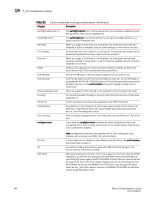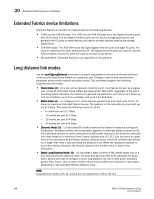HP StorageWorks 1606 Brocade Fabric OS Administrator's Guide v6.3.0 (53-100133 - Page 487
Managing Long Distance Fabrics, In this Long distance fabrics overview
 |
View all HP StorageWorks 1606 manuals
Add to My Manuals
Save this manual to your list of manuals |
Page 487 highlights
Chapter Managing Long Distance Fabrics 20 In this chapter •Long distance fabrics overview 445 •Extended Fabrics device limitations 446 •Long distance link modes 446 •Configuring an extended ISL 447 •Buffer credit management 449 •Buffer credit recovery 457 Long distance fabrics overview The most effective configuration for implementing long-distance SAN fabrics is to deploy Fibre Channel switches at each location in the SAN. Each switch handles local interconnectivity and multiplexes traffic across long-distance dark fiber or wave division multiplexing DWDM) links while the Brocade Extended Fabrics software enables SAN management over long distances. Brocade Extended Fabrics is an optional licensed feature for Brocade SAN deployment over distance beyond 10 km. A Brocade Extended Fabrics license is required before you can implement long distance dynamic (LD) and long distance static (LS) distance levels. The LD and LS settings are necessary to achieve maximum performance results over Inter-Switch Links (ISLs) that are greater than 10 km. For details on obtaining and installing licensed features, see Chapter 16, "Administering Licensing". The Extended Fabrics feature enables: • Fabric interconnectivity over Fibre Channel at longer distances ISLs can use long distance dark fiber connections to transfer data. Wave division multiplexing, such as DWDM (Dense Wave Division Multiplexing), CWDM (Coarse Wave Division Multiplexing), and TDM (Time Division Multiplexing), can be used to increase the capacity of the links. As Fibre Channel speeds increase, the maximum distance decreases for each switch. The Extended Fabrics feature extends the distance the ISLs can reach over an extended fiber. This is accomplished by providing enough buffer credits on each side of the link to compensate for latency introduced by the extended distance. • Simplified management over distance Each device attached to the SAN appears as a local device, an approach that simplifies deployment and administration. • Optimized switch buffering When Extended Fabrics is installed on gateway switches (E_Port connectivity from one switch to another), the ISLs (E_Ports) are configured with a large pool of buffer credits. The enhanced switch buffers help ensure that data transfer can occur at near-full bandwidth to efficiently utilize the connection over the extended links. This ensures the highest possible performance on ISLs. Fabric OS Administrator's Guide 445 53-1001336-01















